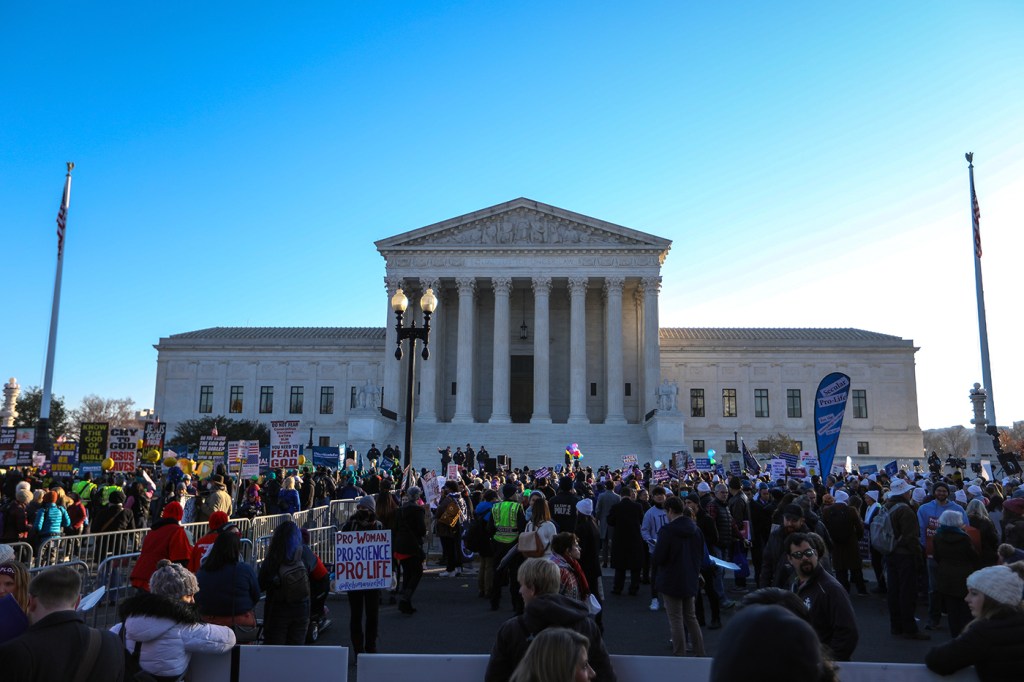Half of US could lose abortion access if Supreme Court overturns Roe v. Wade

With a series of so-called “trigger laws” on the books in 21 states and elected officials hostile to abortion in charge of five more, half the country stands to lose access to abortion if the U.S. Supreme Court overturns Roe v. Wade—the landmark 1973 decision that enshrined the right to abortion before fetal viability. And, during oral arguments in a case over a Mississippi law that flies in the face of that right, it appeared some justices were willing to do just that, say two Northeastern law professors.
Justices heard arguments in Dobbs v. Jackson Women’s Health Organization on Wednesday, a case over a Mississippi law that would ban most abortions after 15 weeks. If it’s upheld, the law would cut down the window for people in Mississippi, and soon thereafter across the country, to have legal abortions by more than two months.
Of course, it’s not a foregone conclusion that the court will throw out Roe, says Martha Davis, university distinguished professor of law at Northeastern, and one of more than 40 researchers, lawyers, and health professionals who have submitted an amicus brief asking the court to strike down the Mississippi law. There are a few ways this could play out.

Left: Martha Davis, university distinguished professor of law at Northeastern, is one of more than 40 researchers, lawyers, and health professionals who have submitted an amicus brief asking the court to strike down the Mississippi law. Photo by Alyssa Stone/Northeastern University. Right: Libby Adler is a professor of law and women’s, gender, and sexuality studies.
First, and most dramatically, the court could overturn its decisions in Roe v. Wade and in the related Planned Parenthood of Southeastern Pennsylvania v. Casey, a 1992 case that upheld Roe but imposed new standard on abortion regulation.
Davis and her colleague Libby Adler, professor of law and women’s, gender, and sexuality studies, agree that it would be a drastic move to overturn a decision that’s been upheld “time and time again,” Davis says—but one that’s not out of the realm of possibility.
To understand why, it’s important to understand the composition of the Supreme Court. Six of the current nine justices, including Chief Justice John Roberts, Clarence Thomas, Samuel Alito, Neil Gorsuch, Brett Kavanaugh, and Amy Coney Barrett, were appointed to the bench by Republican presidents. The remaining three, Stephen Breyer, Sonia Sotomayor, and Elena Kagan, viewed by court-watchers as the more liberal of the current justices, were appointed by Democrats.
“Having a six-person conservative majority is much different than a five-person majority,” says Adler, because it requires far less compromise with the rest of the bench. “Chief Justice Roberts is trying to slow down the train, but essentially, the conservatives don’t need him.”
In other words, if Thomas, Alito, Gorsuch, Kavanaugh, and Barrett decide they want to overturn Roe, they already have the votes to do it, with or without Roberts.
If the court does overturn the 1973 ruling, 21 states have laws or constitutional amendments already in place that would make them certain to attempt to ban abortion as quickly as possible, according to data collected by the Guttmacher Institute, a research and policy organization focused on sexual and reproductive health and rights worldwide.
Some of these states have laws that would be triggered as soon as Roe is overturned, lending them the name “trigger laws” or “trigger bans.” Others have laws or state constitutional amendments that outright ban abortions but which are currently superseded by federal law under Roe.
An additional five states, Florida, Indiana, Montana, Nebraska, and Wyoming, have the “political composition, history, and other indicators—such as recent actions to limit access to abortions—that show they are likely to ban abortions as soon as possible without federal protections in place,” the Guttmacher research shows.
“These kinds of debates would be happening in every state, even the ones that have state constitutional provisions protecting abortion,” Davis says. “Overturning Roe would create an opening for these kinds of discussions across the entire country.”
Another, and potentially more likely, outcome is that the court upholds the 15-week ban in the Mississippi law while claiming to preserve the right to abortion established by Roe. Such a decision might slow the process of states implementing statutory bans, because lawmakers would have to rewrite and pass new laws, Adler says.
In a similar scenario, the court could get rid of the viability line altogether, Adler says, a move that would require states to make abortions available, likely with shorter and shorter windows of time until the right is basically in name only.
“It would be disastrous, for people who want abortion to remain safe and available,” she says.
There’s a third broad possibility, Davis says: The court could overturn Planned Parenthood of Southeastern Pennsylvania v. Casey and preserve Roe v. Wade. But in such a scenario, “the only thing that’s left is that you have a right that can be taken away completely,” she says.
Here’s why.
The court held in Roe v. Wade that inherent in the “due process” clause of the 14th Amendment is a fundamental right to privacy that protects a pregnant person’s choice whether to have an abortion. (The 14th Amendment states that no state shall “deprive any person of life, liberty, or property, without due process of law; nor deny to any person within its jurisdiction the equal protection of the laws.”)
However, this right in the 14th Amendment is balanced against protecting “the potentiality of life,” a balance that shifts over the course of a pregnancy. Under Roe, states can’t regulate abortion at all during the first trimester. During the second, they can only impose regulations that are reasonably related to maternal health. And during the third, once the fetus reaches the point of viability, or the point at which it could survive outside the womb, a state can fully regulate or ban abortion, with some exceptions.
This calculus changed in Planned Parenthood of Southeastern Pennsylvania v. Casey. In the 1992 case, the court eschewed the trimester system and imposed a new standard for regulating abortion: Before viability, a state couldn’t implement an abortion law that created an “undue burden” on the person seeking it.
Without a hard and fast definition of what constitutes an “undue burden,” states—including Mississippi—have passed laws that regulate abortion earlier and earlier in a pregnancy.
“Most people think Roe and Casey will be completely overturned, or at the very least, the viability line will be erased, which means that states could move the line back until there’s zero access to abortion,” Adler says.
For media inquiries, please contact Marirose Sartoretto at m.sartoretto@northeastern.edu or 617-373-5718.





